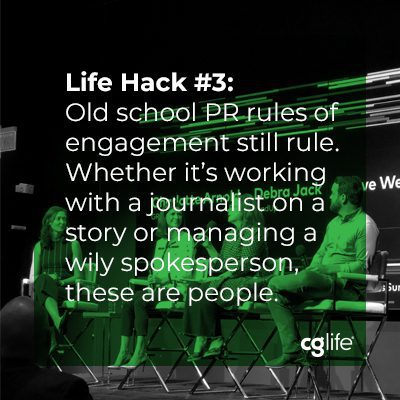I had the good fortune to attend the 2018 GV Comms Summit in San Francisco recently. This unique, annual conference brings together a few hundred communications professionals working within, for, and in the proximity of the 350 or so companies funded by, or associated with, Google’s venture arm,GV (formerly Google Ventures). The vast alumni of communications pros who shape or have shaped the stories touched by Google listened to and participated in panel talks and Q&A sessions featuring storytellers from GV, Alphabet, 23andMe, Stripe, Uber, Grail, eBay, Andreessen Horowitz, and Bloomberg to name just a few. Their mission was simple and clear: share experiences and life hacks and reflect on the role of the communicator in both a startup or established company and how that role evolves over time. So, reflect, I did. I listened and learned. Throughout the day, I also heard some things that I already knew, but was pleasantly reminded, that collectively represent key public relations best practices I first learned when starting in this field (gulp) two-plus decades ago.
- Hire smart and talented people, then turn them loose. You hired them because they’re good at what they do, which is what you need them to do. Give them the room to run.
- Before you try to spin a story, make sure that you have a story. Trying to put the best face on a story angle or situation when you have no substance, facts or standing is a sure-fire way to lose in PR. Include the substance behind it.
- Old school PR rules of engagement still rule. Whether it’s working with a journalist on a story or managing a wily spokesperson, these are people. You have to listen, empathize and negotiate like you do in any human relationship.

- In a crisis, have a team already in play that can work together under stress. After a crisis occurs is not the time to start talking about how a company should handle a crisis. Planning ahead and having a team formed that can handle the situation are critical.
- Be as positive and transparent as you can possibly be. Positive attitudes and openness, whether it’s in your agency or company, can go a long way toward building trust and credibility across the team and between management and the broader groups. When the shit hits the fan, that trust and credibility will be the glue that holds the team together.
- Technology is great, except when it’s not. In our hyper-fast work environment in which we are communicating with colleagues via email, phone, text message and across multiple social media platforms – even when they might be physically located right down the hall – tech can get in the way and messages, ideas and nuances are lost. It is critical to meet with peers and teams in person (the original social network) whenever possible. IRL Fridays, anyone?
- Don’t go chasing waterfalls. Have a focused story and set of communications objectives, and stick to them. Resist the urge to stray from your core story and goals. Doing so simply muddies your story and spreads thin your time and resources in chasing dead ends.
- Just say no to yes people. Speak your mind, always. Genuine perspective and the fearlessness that comes with speaking truth to leadership are rare commodities in the world. However, smart leaders know that they should surround themselves with people and teams that tell them what they need to know, not what they want to hear.
While many of these lessons were not necessarily new to me, they were heartfelt reminders of the core values and approaches that we must embrace and enforce in the field of communications and public relations. These lessons also gave me hope for the next generation of storytellers who are learning the right way to tell their story. Note: Major props to Jodi Olson, GV’s communications partner, who did a remarkable job planning, hosting and emceeing the day’s sessions.
